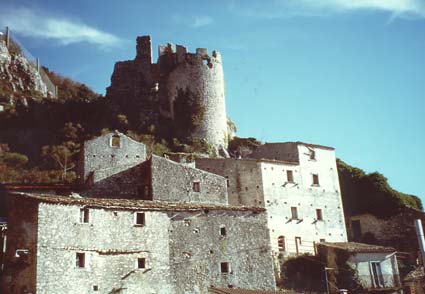![]() Castles
Castles
![]() Castle-enceinte of Pesche
Castle-enceinte of Pesche
 |
Castle-enceinte of Pesche |
Castrum
Pescharum, Pesclis, Pescla, are names given to the burgh that rises on the slopes of Mount San
Bernardo. These appellations originate from the Latin word pesclum,
indicating a place abounding with good construction stone. Built to control the
Pescasseroli-Candela sheep-track, Pesche, according to the Catalogus Baronum,
belonged to William. Until the 15th century it was the property of
the Abbey of Montecassino.
The village is well preserved and protected by an enclosing wall. Its tall stone
buildings, which date back to the last century, rise to a height of up to five
storeys on a steep slope, commanding a picturesque view of the surrounding
countryside.
The castle of Pesche follows the rule according to which the built-up area
represents the first obstacle that a besieger must surmount. An enceinte,
interrupted by cylindrical curtain towers (corner towers and smaller midway ones),
climbs the steep mountainside and encloses the burgh, which served as a barrier
that made it impossible to transport war machines. A series of installations
provided an effective defence from attack from the upper slopes of the mountain:
a redoubt with the characteristics of a small donjon, raised on an
escarped base, a good flanking system featuring a large number of loopholes and
defence apparatuses for dropping missiles. Traces of wooden structures (floors
and reinforcing bars) are still visible at some points in the curtain walls,
which were built using mixed local stone of varying dimensions laid with great
precision.
Pesche is a significant example of a castle-enceinte with a defence redoubt that
reminds one of the Abruzzo models (S.Pio delle Camere, for example) more than of
those in the other Molisian settlements.